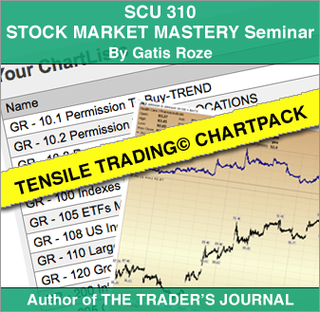
This is an invitation to the 500-plus investors who have downloaded the Tensile Trading ChartPack to download the free Q2/2014 (Version 3.0) of the ChartPack.
This is also an invitation for those of you who have not yet done so to check out the full description and sample charts at:
A) Bookstore: http://store.stockcharts.com/collections/stockcharts-com-chartpacks/products/tensile-trading-chartpack-by-gatis-roze
B) November 7th Blog: http://blogs.stockcharts.com/journal/2013/11/the-tensile-trading-chartpack-users-manual-organized-optimized-for-maximizing-profits.html
Version 3.0 Upgrades
- I’ve added a similar sister ETF to each of the 9 sector chartlists (401-409) that offers both an alternative potential ETF investment (albeit in the same relative sector space) as well as a comparative for monitoring. In other words, Chartlist 408 is the S&P Healthcare Sector ETF (XLV) that also includes the largest individual equity holdings comprising XLV. I have now added VHT – an alternative yet similar ETF (with slightly lower fees) that you might consider as a surrogate for XLV.
- Many stocks, ETFS and mutual funds make distributions over the year. These distributions tend to be dividends or capital gains and occur on a relatively repetitive schedule. Knowing these dates is essential for every potential buyer or seller of these equities. Not all examples are as widely remembered as the Fidelity Magellan distribution of May 5, 2006 where the change in managers resulted in the new manager selling many of the previous manager’s holdings – an action that triggered a capital gains distribution of approximately 33%. In other words, if you ignored the fact that FMAGX historically made distributions in early May and you bought the fund on May 3rd, then on May 5th you would have received 33% of your money back as a capital gains distribution and would have owed income tax on that money. Very painful and very expensive.
For these distribution dates, I like to use Yahoo Finance where you can enter the ticker symbol and under the quotes tab, check on historical prices and past dividend distribution dates. This won’t show you future dates, but the past dates are a very dependable guide. In this ChartPack update, I’ve included those dates in all three sample chartlists:
740 – Sample Stock chartlist for Johnson & Johnson (JNJ)
760 – Sample ETF chartlist for S&P Healthcare Sector
780 – Sample Mutual Fund Vanguard Healthcare Fund
These distribution dates can be viewed in either the edit format or the 10-per-page format. I would strongly encourage you to do likewise on all your owned positions.
- Chartlists 420-12 through 420-88 have been updated to reflect Fidelity’s most recent accumulations (new buys) and recent sells. This exercise continues to yield a significant number of key insights that I’ll share in a separate upcoming blog. Each chartlist contains the individual Fidelity Sector Fund and the top 8 to 10 individual equities accumulated for that fund. I would suggest you keep the “GR” prefix on these and don’t rename them. That way, you’ll be assured that you have Fidelity’s latest holdings reflected in your chartlist.
In these updates, I’ve placed a star (*) after each new equity added to the top 10 holdings over the past 3 months making it easily apparent what Fidelity’s new ‘buys’ actually were. On average, approximately 20% of the top 10 holdings changed for the majority of the 40 Fidelity Select Funds. Please take special note: when the Natural Gas Fund (FSNGX) has a 60% turnover, the industry itself is probably in the throws of significant agitation and your radar should go up!
- To assist you in optimizing your palette of chartlists and helping with some useful logistical suggestions, I’d suggest you review the blog I wrote about Version 2.0.
Trade well; trade with discipline!
-- Gatis Roze
UPGRADE INSTRUCTIONS FOR EXISTING CHARTPACK USERS:
Important: If you have modified any of the charts in any of the ChartLists that start with “GR - ”, those changes will be deleted as part of the upgrade process. If you want to keep those changes, you need to copy those charts into a different non-"GR" ChartList before you upgrade!
To Upgrade the Tensile Trading ChartPack, follow these steps:
- Log in to your account and then click on the "Your Account" link in the upper right corner of the web page.
- Scroll down and find the "ChartPacks" area towards the bottom of that page.
- Find the entry for the "Tensile Trading" ChartPack in the table that appears. (If you don't see it, that means that you didn't purchase it - click here to purchase it.)
- Click on the "Re-Install" button next to the Tensile Trading ChartPack to start the reinstall process.
The download should take about 15 seconds. At that point, you can explore the new chartlists and updates.
